Robinson R22 Beta II
JJ Helicopters, Inc., N702JJ
San Pedro, California
January 4, 2017
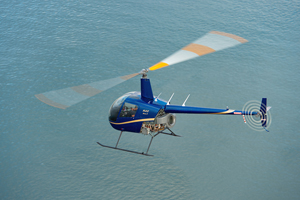
Source: Robinson Helicopter Company
On January 04, 2017, 1736 PST, a Robinson R22 Beta II helicopter crashed approximately one hour after departure from Torrance Municipal Airport (TOA). The helicopter was en route to the Los Angeles Harbor area to take aerial photos of several cruise ships. The helicopter crashed on the inland side of a jetty, southwest of a lighthouse at the end of the jetty after spinning, descending rapidly and impacting the water. The helicopter came to rest in about 18 feet of water with both pilot and photographer fatally injured.
The flight was operating under 14 CFR Part 91 as an aerial photography flight. Weather at the time of the accident was scattered clouds and overcast with eight miles visibility. Night visual meteorological conditions prevailed at the time and no flight plan had been filed.
The National Transportation Safety Board (NTSB) determined the probable cause of this accident to be the pilot's failure to use carburetor heat while operating in conditions conducive to carburetor icing, which resulted in a loss of engine power due to carburetor icing. Also causal was the pilot's failure to maintain rotor revolutions per minute (RPM) during autorotation following the loss of engine power.
NTSB Accident Number: WPR17FA047
History of Flight
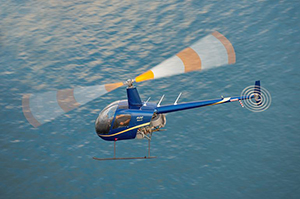
Source: Robinson Helicopter Company
On January 4, 2017, at 1635 PST, a Robinson Helicopter Company R22 Beta II, N702JJ, departed from the operator's ramp area located at Torrance Municipal Airport, Torrance, California. The helicopter with the commercial pilot and passenger/photographer was en route to the Los Angeles Harbor area to take nighttime aerial photographs of several cruise ships in the harbor.
Radar data used by the investigators indicated that while in the Los Angeles Harbor area, the helicopter made several circles then proceeded on a perpendicular course to the jetty that terminated near a lighthouse at the mouth of harbor. The last few radar targets indicate a sharp turn to the right and then terminated on the inland side of the jetty.
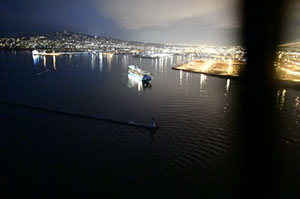
Source: NTSB
Cruise ship witness accounts stated the cruise ship was exiting the harbor mouth at the time of the accident. The helicopter started spinning as it descended straight down and crashed into the water at 1736 PST. One witness commented that it was "just dark enough to make it difficult to see the helicopter, all you could see clearly were the [spinning] lights."
It was reported that local agencies initiated a search, and the wreckage was located at about 1015 the following morning. The wreckage was upright at the end of the jetty on the inland side, southwest of the lighthouse and in about 18 feet of water. Rescue teams found both victims inside the helicopter in their seats with belts fastened. The pilot was found wearing his helmet and an inflated life vest. An autopsy of the pilot determined cause of death to be drowning.
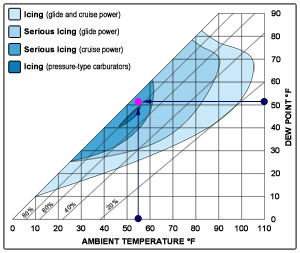
Source: FAA SAIB CE-09-35
View Larger
Carburetor Icing
Weather at the accident site was visual conditions with visibility at ten miles. It was night at the time of the accident with wind speed at four knots. The temperature/dew point was 55o F / 52o F respectively. Relative humidity was 88%. Based on this information, the conditions at the time of the accident were conducive to serious carburetor icing at cruise power as advised in FAA Special Airworthiness Information Bulletin (SAIB) CE-09-35.
For additional information:
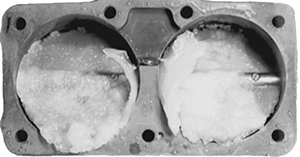
Source: NASA Carb Ice Report
R22 Carb Ice Presentation - No Ice Thank You
R22 Beta II Accident Animation
Carburetor Heat, Temperature and Carb Icing Video - Helicopter Ground School
R22 - Deicing and Carburetor Heat - Upper Limit Aviation
Carb Ice Effects and Mitigating Action on Fixed Wing Video - SmartPilot.ca
It was difficult for investigators to prove that carburetor icing was responsible for the cause of this accident, as ice evidence usually melts before they arrive. Investigators concluded that carburetor ice most likely led to the loss of engine power which contributed to the chain of events that caused the accident.
Air flowing through a carburetor's Venturi inlet results in a pressure drop and associated temperature drop. The temperature drop, in conjunction with cooling due to fuel vaporization, may cool the fuel/air mixture below freezing even on relatively warm days. If humidity is also present, ice can form in the carburetor. If not mitigated with the activation of carburetor heat, the accumulating ice can disrupt air and fuel flow to the engine, resulting in a decrease in engine performance or a power interruption.
Most of the information regarding carburetor icing is based on fixed-wing airplanes with a reciprocating engine. Although helicopter engines are similarly susceptible, the results for helicopters can be more severe. If a fixed-wing airplane with a reciprocating engine loses power because of carburetor icing, air flowing through the propeller keeps the engine turning since it is directly connected to the propeller. This allows the engine to restart quickly once the ice has melted.
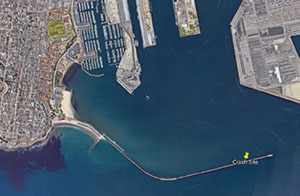
Source: NTSB
View Larger
Helicopters are designed to allow the rotors to disengage from the transmission and engine so they continue to turn using the inertia of the rotor blade and the freewheeling clutch when the engine loses power (autorotation). As a result, during a carburetor icing event in a helicopter, the reciprocating engine may come to a complete stop and would require an active restart procedure by the pilot. This can be difficult since helicopter control generally requires both hands and feet on the primary controls. Manipulating mixture controls and ignition switches is generally not accomplished in flight. Additionally, ergonomic concerns aside, there may not be enough time to accomplish a restart following an engine failure at low altitude. In such a case, a successful power-off landing is dependent on the energy state of the helicopter within the Height-Velocity diagram.
As established in guidance provided by both the FAA and the manufacturer, the carburetor heat system should be activated when conditions are conducive to carburetor ice or even if carburetor ice is suspected. Pilots should familiarize themselves with the carburetor heating system for all helicopters they are operating and should become proficient in the operation of these systems.
During flight planning, pilots should review guidance to determine if meteorological conditions are conducive to carburetor icing. Pilots can also mitigate the effects of carburetor ice by activating the helicopter’s carburetor heat system before ice starts to form within the carburetor to maintain engine performance and prevent a reduction or loss of engine power. The pilot should adjust carburetor heat whenever carburetor icing conditions are suspected or when there are warning signs of carburetor ice forming, including:
- A drop in rotor RPM
- A drop in engine manifold pressure
- A roughness in engine operation
Pilots should be aware the R22 governor automatically adjusts the throttle to maintain a constant RPM. Pilots should understand that in conditions conducive to carburetor ice, the onset of the loss of engine power can be masked by the governor. As ice starts to accumulate in the carburetor, power starts to gradually decrease. The governor automatically starts to increase throttle to maintain engine RPM (maintaining the required manifold pressure as a result). Therefore, signs such as RPM or manifold pressure loss may not occur until the condition is severe. This results in a masking condition so that gradual power loss might not be apparent to the pilot. The manufacturer’s guidance advises that when in doubt about the meteorological conditions that can cause carburetor ice, adjust the carburetor heat system as required during hover, climb, or cruise.
Height-Velocity Diagram
The height-velocity (H-V) diagram graphically presents combinations of height and speed from which the helicopter energy state is too low that an autorotation (power-off) landing may not be possible. Outside of the H-V diagram, (non-shaded area) successful power-off landings have been demonstrated in zero wind and at maximum weight. Inside the H-V diagram, the likelihood of a successful power-off land is greatly reduced due to the lower altitude and speed of the helicopter as well as reduced pilot reaction time. Flying within the shaded area of the H-V diagram is not prohibited; however, prolonged flight in this area increases the risk for an unsuccessful autorotation in the event of an engine loss of power.
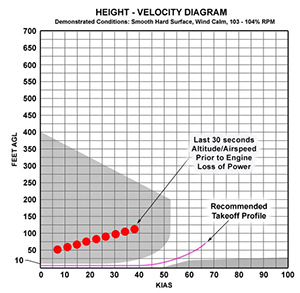
Source: Robinson Helicopter Company R22 Pilot Operating Handbook, Section 2 Limitations
View Larger
Autorotation landings require a sufficient helicopter energy state as well as pilot reaction time to initiate and complete. If a pilot initiates an emergency autorotation landing within the shaded area of the H-V diagram, it may be impossible to complete the landing without causing damage to the helicopter or injury to the pilot and occupants.
For example, if airspeed should increase without a corresponding increase in height, the pilot’s reaction time could be insufficient to initiate a flare to prevent a high-speed ground impact. Also, an increase in height without a corresponding increase in airspeed could be dangerous as a crash from this height may not be survivable should an engine lose power occur. Sufficient airspeed coupled with the appropriate altitude, as graphically represented in the regions outside the shaded area of H-V diagram, increases a successful outcome of an emergency autorotation landing.
Using the last 30 seconds of the radar data for the flight of the R22 Beta II, the altitude (feet) and air speed (knots) were plotted against the H-V diagram for the helicopter. Investigators noted that the helicopter was operating in the darker shaded area of the diagram, which indicates the highest relative risk in operations and makes a successful autorotation highly unlikely in the event of power loss.
For additional information on the H-V diagram:
R22 Beta II Accident Animation
Height Velocity Diagram Video - Helicopter Ground School
Post-Accident Wreckage/Engine Examination

Source: NTSB
View Larger Pic 1, Pic 2, Pic 3
All major components of the helicopter were recovered except the outboard three-fourths section of one main rotor. According to the investigation, both main rotor blades were bent down at the hub and then bent upward about two feet from the hub. The intact main rotor blade exhibited coning, indicating low RPM of the blades at impact. This is consistent with low or no engine power at the time of impact.
The throttle, mixture, and carburetor heat controls were connected at both ends with the airframe structure collapsed around the controls, preventing the controls from being moved. This effectively locked the controls in place at the time of impact. The throttle arm at the carburetor was about three-fourths open. The fuel mixture control was in the full rich position.
The carburetor heat control knob was in the full down or "OFF" position and unlocked. This could have indicated that the carburetor heat system was not in operation at the time of impact.
There was no indication of catastrophic engine failure or fuel contamination as contributing to the cause of the accident.

Source: NTSB
View Larger Pic 1, Pic 2, Pic 3
Conclusion
Carburetor icing continues to be a major factor in aviation accidents. A review of the NTSB accident database identified 301 accidents attributed to carburetor ice between 1983 through 2021. Of these accidents, 30 resulted in fatalities. In 1977, 14 CFR 27.1093 and 14 CFR 29.1093 were amended to require that reciprocating engines, including those used on helicopters, have a means of preventing ice in the engine's air induction system. Despite this certification requirement, the accident trend regarding carburetor icing has remained a steady, high rate throughout the years according to information from the manufacturer, the FAA, and the Aircraft Owners and Pilots Association (AOPA).
In addition to the pilot's failure to activate the carburetor ice assist system, he continued to operate in a high-risk condition. Also, continuous operation within the shaded area of the H-V diagram could impede a successful autorotation landing if engine power is lost due to carburetor ice.
The NTSB determined the probable cause of this accident to be the pilot's failure to use carburetor heat while operating in conditions conducive to carburetor icing which also resulted in a loss of engine power. Also contributing to this accident was the pilot's failure to maintain rotor RPM following the loss of engine power which precluded successful autorotation of the helicopter into the water.
NTSB Accident Number: WPR17FA047
FAA Airworthiness Directive (AD) 97-02-14, Throttle Governor and RPM Warning Adjustment
Prior to this accident, the FAA determined that all R22 helicopters must be equipped with a functioning RPM governor. The purpose was to minimize the possibility of pilot mismanagement of the main rotor RPM which could result in an unrecoverable main rotor stall and subsequent loss of control of the helicopter.
Special Airworthiness Information Bulletin (SAIB) CE-09-35, Carburetor Icing Prevention
This SAIB was written to inform pilots of the potential hazards associated with carburetor icing.
This amendment was made applicable to Robinson Helicopter Company model R22 helicopters that require installation of an improved throttle governor; an adjustment to the low RPM warning unit threshold to increase the RPM at which the warning horn and caution light activate; and revisions to the R22 Rotorcraft Flight Manual that prohibit flight with the improved throttle governor selected off, except in certain situations.
Robinson Helicopter Company Safety Notice SN-24 Low RPM Rotor Stall Can Be Fatal
Manufacturer's guidance that rotor stall due to low RPM causes a high percentage of helicopter accidents, both fatal and non-fatal.
Robinson Helicopter Company Safety Notice SN-25 Carburetor Ice
Manufacturer's guidance that avoidable accidents have been attributed to engine stoppage due to carburetor ice. Pressure drops and fuel evaporation inside the carburetor cause significant cooling. When in doubt, assume conditions are conducive to carburetor ice and adjust carb heat as required.
Robinson Helicopter Company Safety Notice SN-10 Fatal Accidents Caused by Low RPM Rotor Stall
Manufacturer's guidance on conditioning pilot reflexes to instantly add throttle and lower collective to maintain RPM in any emergency.
Robinson Helicopter Company Safety Notice SN-31 Governor Can Mask Carb Ice
Manufacturer's guidance that with the throttle governor on, loss of power due to carburetor icing will not become apparent as a loss of either RPM or manifold pressure. The governor automatically adjusts throttle to maintain constant RPM which also results in constant manifold pressure. It is recommended that when in doubt, adjust carburetor heat as required or in the case of the R22 Beta, the carb heat assist system.
Robinson Helicopter Company Section 5 Performance, Height Velocity Diagram
Specific guidance from helicopter manufacturer on height-velocity diagram.
14 CFR 27.1093 - Induction System Icing Protection, as amended
(a) Reciprocating Engines.
Each reciprocating engine air induction system must have a means to prevent and eliminate icing. Unless this is done by other means, it must be shown that, in air free of visible moisture at a temperature of 30 degrees F., and with engines at 75 percent of maximum continuous power--(1) Each rotorcraft with sea level engines using conventional venturi carburetors has a preheater that can provide a heat rise of 90 degrees F.; (2) Each rotorcraft with sea level engines using carburetors tending to prevent icing has a sheltered alternate source of air, and that the preheat supplied to the alternate air intake is not less than that provided by the engine cooling air downstream of the cylinders; (3) Each rotorcraft with altitude engines using conventional venturi carburetors has a preheater capable of providing a heat rise of 120 degrees F.; and (4) Each rotorcraft with altitude engines using carburetors tending to prevent icing has a preheater that can provide a heat rise of- (i) 100 degrees F.; or (ii) If a fluid deicing system is used, at least 40 degrees F.
Aerial Photography
To perform effective aerial photography, a photographer prefers that the helicopter be flown in a low, slow, and steady manner to assist in capturing quality images. For the pilot to accomplish this, he may have to operate at altitudes and airspeeds that could fall into the shaded area of the H-V diagram. Flying in the shaded area of the H-V diagram could be potentially dangerous if an emergency should occur such as the loss of engine power or a loss of tail rotor effectiveness.
- Prolonged operation in the H-V diagram - The pilot did not refrain from prolonged operation within the shaded area of the H-V diagram, resulting in increased risk to maintain sufficient time for autorotation
- Operating in conditions conducive to carb ice - The pilot likely did not understand carburetor icing and mitigating its effects on engine performance
Pilots understand the factors leading to the formation of carburetor ice and adjust carburetor heat appropriately.
- The NTSB noted after examination of the wreckage that the carb heat knob was in the down (off) position, indicating the carburetor heat system was not activated. This could signify that the pilot did not believe he was flying in conditions that were conducive to carburetor icing. Review of FAA Special Airworthiness Information Bulletin (SAIB) CE-09-35 and the Robinson Helicopter Pilot Operating Handbook would indicate that the meteorological conditions at the time of the accident were conducive to carburetor icing or suspected, and the carb heat system should have been activated.
Pilots understand the need to refrain from prolonged operation within the shaded area of the height-velocity diagram.
- A review of the last few radar targets indicated a sharp turn to the right and terminated on the inland side of the jetty of the Los Angeles Harbor. The data points recorded for the last 11 minutes of flight indicated that the rotorcraft altitude varied between 100 and 700 feet. This suggests that the pilot was flying in the shaded area of the H-V diagram. Pilots are advised by Robinson Helicopter Company to avoid flying in this area of the H-V diagram as it makes conducting a successful autorotation landing difficult if an engine power loss occurs.
Pilots objectively review their flight experience and training and apply this knowledge to the assigned flight to determine if they have the appropriate requirements to conduct safe operations.
- It would have been appropriate for the pilot to refuse the assignment based upon his experience level as a pilot (100 hours total flight experience in rotorcraft) and the nature of the flight assigned (aerial photography). Additionally, the pilot should have considered the meteorological (conducive to carb icing) and visual conditions (low light, over water, evening), that were important factors during the time of operation.
Carburetor Ice
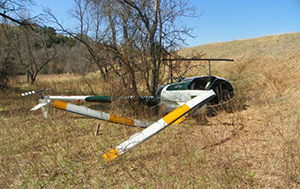
Source: NTSB
On April 5, 2012, in Isabel, South Dakota at about 0700 mountain daylight time, a Robinson R22 Beta helicopter impacted terrain while maneuvering at low altitude. The helicopter descended, impacted trees and terrain, and rolled on its right side. A post-accident examination of the helicopter did not reveal any evidence of pre-impact mechanical malfunction or failures that could have contributed to the accident. Based on the temperature and dew point about the time of the accident, conditions were conducive to serious icing at any power setting. The pilot reported that he was unsure if he had used carburetor heat for the accident flight. Available evidence suggests that the engine partially lost power in the absence of carburetor heat while operating in conditions conducive to carburetor icing.
Accident Number: CEN12LA230
H-V Diagram
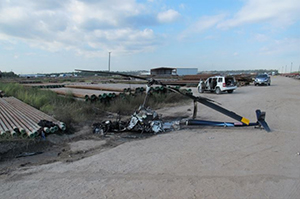
Source: NTSB
Photo copyright - used with permission
On September 10, 2012, in Houston, Texas at about 1545 central daylight time, a Robinson R22 Beta helicopter impacted terrain while maneuvering at low altitude due to apparent loss of engine power. The pilot and passenger were fatally injured. Witnesses observed the helicopter descending vertically to the ground as the body of the helicopter spun around the main rotor blades. A postimpact fire consumed most of the helicopter.
A post-accident examination of the helicopter did not reveal any evidence of pre-impact mechanical malfunction or failures that could have contributed to the accident. Although the weather conditions at the time of the accident were conducive to the formation of carburetor icing at cruise and glide power settings, investigators could not conclusively determine that carburetor ice caused the loss of engine power. The cause of the power loss could not be determined. Investigators determined the probable cause of this accident to be the pilot’s failure to maintain control of the helicopter after a loss of engine power. At the time of the engine loss of power event, the helicopter was operating in the shaded area of the H-V diagram which contributed to the unsuccessful autorotation of the helicopter and this accident.
Accident Number: CEN12FA621
Rotorcraft Life Cycle:
- Operational
Accident Threat Categories:
- Loss of Control - Inflight (LOC-I)
- Low Altitude Operations (LALT)
- System/Component Failure or Malfunction (powerplant) (SCF-PP)
Industries:
- Aerial Observation
Accident Common Themes:
- Human Error
- Flawed Assumptions
Flawed Assumptions
Although there were no known atmospheric icing conditions that would have precluded this flight, meteorological conditions at the time of the accident were conducive to the formation of carburetor ice. Examination of the pilot controls revealed that the carburetor heat control knob was in the "OFF" position which indicated that the pilot failed to adjust carburetor heat during the flight.
Human Error
Carburetor Ice
The pilot’s failure to adjust carburetor heat while operating in conditions conducive to carburetor icing led to the loss of engine power and resulted in a loss of control in flight.
H-V Diagram
While operating in the shaded area of the H-V diagram, the pilot failed to manage engine power and maintain adequate main rotor RPM, precluding a successful autorotation.
A review of the NTSB accident database has identified 301 airplane and helicopter accidents attributed to carburetor ice between 1983 through 2021. Of these accidents, 30 resulted in fatalities. The certification requirements for carbureted aircraft (14 CFR 23.2415 and 27.1093) require that a heated source of air be provided as mitigation for carburetor icing. The FAA and the Aircraft Owners and Pilots Association (AOPA) have addressed the subject of carburetor icing several times in various forms. Despite the certification requirements and information provided by the manufacturers, FAA, and AOPA, the accident trend has remained steady throughout the years.
Technical Related Lessons
To maintain safe flight, pilots need to refrain from prolonged operation within the higher risk shaded area of the height-velocity diagram. Pilots should be prepared to perform emergency procedures such as an autorotation if engine power is lost. (Threat Category: Loss of Control - Inflight)
- A pilot's training, skills, and experience, along with observance of proper helicopter operational procedures and design limitations, are crucial to safe flying. Pilots should be prepared for any situation that may necessitate an emergency autorotation when a loss of engine power occurs.
- Investigators determined the pilot, while conducting aerial photography operations, flew the helicopter continuously in the shaded area of the H-V diagram. Specifically, the pilot entered a low-altitude, low-airspeed condition from which he could not recover once the engine lost power. This combination of low altitude and low airspeed did not allow for a successful autorotation when engine power was lost due to carburetor ice.
Common Theme Related Lessons
Pilots need to constantly monitor flight meteorological conditions, especially those conditions regarding temperature, dew point, and humidity that could result in carburetor icing. Pilots must take mitigating action such as activating the helicopter's carburetor heat assist system to properly manage engine power. (Common Theme: Human Error)
- Ice can form within the carburetor even in the absence of freezing weather conditions. When meteorological conditions are conducive to carburetor ice, the Venturi effect of the carburetor inlet of a reciprocating engine reduces atmospheric pressures so that a temperature drop occurs and allows the formation of ice. This can restrict the flow of fuel to the engine resulting in reduced engine performance or even engine failure.
- Investigators established the meteorological conditions at the time of the flight were conducive to serious carburetor icing at cruise power.
- It was also determined the carburetor heat assist control knob was in the "OFF" position. This indicated that the pilot failed to adjust carburetor heat during the flight which could have prevented ice from forming in the carburetor and could have prevented the loss of engine power which led to an inflight loss of control of the helicopter.
- The pilot's failure to activate or adjust the R22 carb ice system was determined to contribute to this accident.
